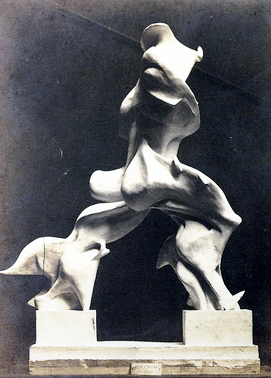Futurism was founded in Italy around the beginning of the 20th century. It is widely recognized for its busy paintings which are highly dynamic in terms of line and colour, and emulated the speed at which the 20th century was traveling in terms of progression. They included abstract depictions of youth, technology and speed and were fascinated by the new modes of transport becoming widely available to them. This was also captured in the sculptures of the Italian artist Umberto Boccioni.
Unique Forms of Continuity in Space was originally a plaster cast, depicting a human striding forwards (some say into the future). The pose is static, yet there is so much movement within it’s confines, the statue seems to fluctuate between very small variations of the pose, almost as if the man captured was completely trapped yet the essence of his struggle to leave the past behind and progress into a future world. It’s as if the muscles have forgotten their corporeal form and turned to a liquid, breaking the boundaries of the human form and swimming out into the surrounding space. It twists and turns with such grace and movement that provides beautiful contrast between the sharp hard edges, and the soft smooth flowing curves of sinew. The stance is incredibly powerful, resembling a triangle with its wide heavy base. There is an incredible amount of mass in the legs, making the figure look almost immovable, despite it’s fluidity.
Futurism was also an important movement within music. George Anteill’s “Piano Sonata No.2 – The Airplane” embodies the fast passed confusion of the futurists, with it’s only stage direction as “ to be played as fast as possible” . The music itself is very beautiful, but anything from calming, even in it’s slower more legato, repetitive stages, the notes contrast with each other, creating peculiar harmonies that are uncomfortable yet wonderfully modern.
“Morning in the Woods” by Lee Ornstein is another beautiful piece which is less obviously futurist, but to me seems innovative in that the treble and bass clef sound totally independent of each other at times, leading to clashing of notes, with played for the shortest time with the rest of the piece sounds beautiful. The music is ethereal, describing the otherworld that can only ever be reached by a journey through the woods at dawn, and echoes the overwhelming spiritual completion one feels as the first rays of sunlight breach the trees. The quiet contemplative nature of the music at about 4.20 reminds me of the isolation you find in the woods at that time, and while beautiful, also captures the underlying paranoia felt when alone in a cluster of trees.
In contrast, Ornstein’s “Impressions of the Thames” is much louder, busier, and more mechanical. It captures the overwhelming nature of the growth of technology, the loud noises that would have sounded so foreign at it’s birth, and possibly frightening. This piece uses an extraordinary amount of pedalling which often causes very long strings of notes to run together creating new sound with heavy bass and incredible presence and scale. The treble clef notes seem dark, swift, sudden and unexpected leading to the overwhelming sense of foreboding, and possible impending danger.
Note clusters rarely seem to follow traditional patterns sounding uncontrollable, and echoing the unpredictability of the waves crashing against the dock. The whole piece just gives off a palpable aura of largeness, sounding as though the machines are completely outwith our control. There is also a big contrast between the legato and staccato elements, which seem comparatively high pitched and strange. The ending sounds unresolved due to the lack of cadence, leading us to believe that the piece isn’t really finished, just as progression will never really be finished.
George Antheill’s “Ballet Mechanique” is frantic to say the least. It starts off sounding like a desperate chase, something whimsical and mostly defenceless running desperately from an industrialised monster depicted with violent crashes. I love that the piano and xylophone seem to echo each other for parts in this, and the sounds of the piano on it’s own even sound quite traditional, contrasting with the rest of the piece. The small sounds made by the xylophone and triangle are reminiscent of small fixtures and cogs, all working in tandem to create one large machine. You could even say that these instruments are mischievious sounding, like little mechanical elves working to do their jobs in a factory, while at around 6 min the broken chords of the piano, along with the drums and xylophone sound like something that could have inspired Danny Elfman (I’m thinking the Beetlejuice theme). After this, the piano takes a return to whimsicality, almost trying to lure us in before what sounds like a school bell rings and all the instruments start rushing around, panicked. What sounds like a random assortment of noises to an outsider is, I’m sure, in reality deliberately chosen pieces that fit together precisely, creating the musical equivalent of a complex machina. Chaotic organization.
Sources:
McKever, R. “Umberto Boccioni, Unique Forms of Continuity in Space”
http://smarthistory.khanacademy.org/umberto-boccioni-unique-forms-of-continuity-in-space.html (1/12/13)
